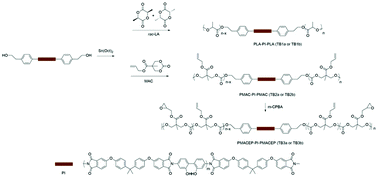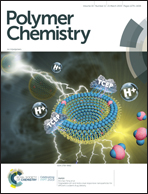Synthesis of epoxidized poly(ester carbonate)-b-polyimide-b-poly(ester carbonate): reactive single-walled carbon nanotube dispersants enable synergistic reinforcement around multi-walled nanotube-grafted carbon fibers†
Abstract
Polyimides (PI) generally have a high affinity for single-walled carbon nanotubes (SWNTs), but they suffer from poor solubility in most low boiling point organic solvents and low compatibility with common resins (such as epoxy) used in composites, limiting their suitability as dispersants. PI block copolymer systems containing reactive poly(ester carbonate)s have not yet been reported and are expected to act as effective reactive dispersing agents of SWNTs. Herein, PI-derived block copolymers are synthesized via ring-opening copolymerization of lactide (LA) (a control monomer) and allyl-bearing 2-methyl-2-(allyloxycarbonyl)-propylene carbonate (MAC) from the OH-terminal ends of the PI block to produce PLA-PI-PLA (TB1, a control) and PMAC-PI-PMAC (TB2). The allyl pendant group of TB2 allows further facile functionalization to form a third series of epoxidized (EP) derivatives, i.e. PMACEP-block-PI-block-PMACEP (TB3). TB3 copolymer when mixed with a conventional structural epoxy resin forms blends that do not show inferior tensile properties compared with the epoxy, which is unusual. Furthermore, the mixing solvent tetrahydrofuran (THF) can be readily evaporated off after forming the blends. TB3-dispersed (2 wt%) SWNTs added to epoxy increased the tensile strength, modulus, and elongation at break of the resulting nanocomposite films by 40%, 34%, and 26% respectively, compared to the baseline epoxy resin. Furthermore, when TB3b triblock-dispersed SWNTs in epoxy were combined with fuzzy carbon fibers, i.e. carbon nanotube-grafted-carbon fibers (CNT-g-CF), a synergistic interfacial strength reinforcement was observed, together with shifting of the failure mode from the matrix interphase to the carbon fiber-grafted nanotube interface. The ultimate interfacial shear strength between the TB3-dispersed SWNT-epoxy matrix and the fuzzy carbon fibers (i.e., fibers having carbon nanotubes grown on them) measured via single fiber pull-out tests was 100 MPa, which was ca. 11% improvement over the baseline unsized carbon fiber in neat epoxy. To our knowledge, this is the first evidence of a synergistic enhancement in interfacial properties when fuzzy carbon fibers are combined with a SWNT-reinforced epoxy using the new epoxidized TB3 nanotube dispersing agent that forms a strong covalent TB3–epoxy interface. The new functionalizable TB3 synthesis route introduced here is generalizable to other PI-based copolymers with diverse functionalities and solvent compatibilities.



 Please wait while we load your content...
Please wait while we load your content...